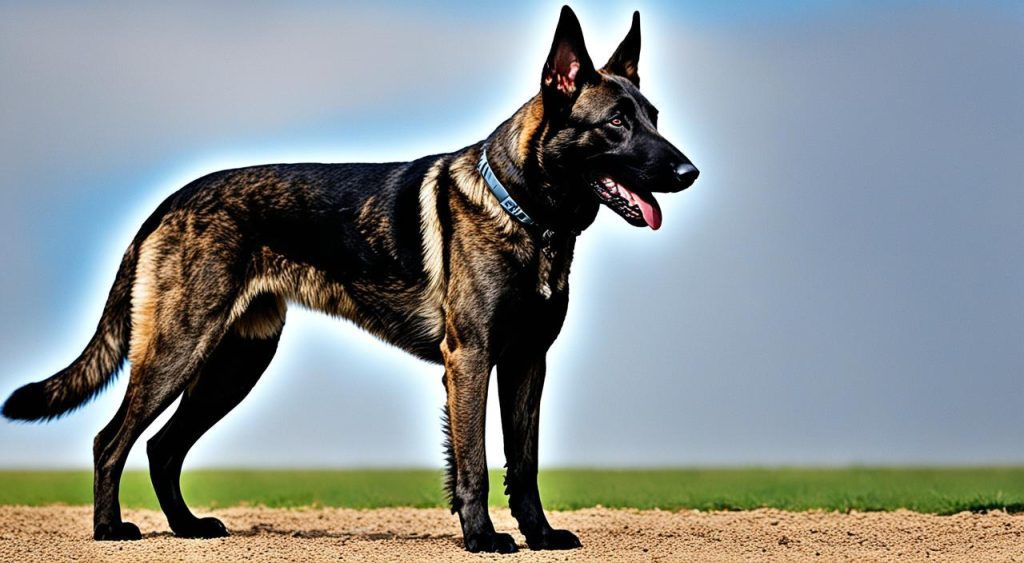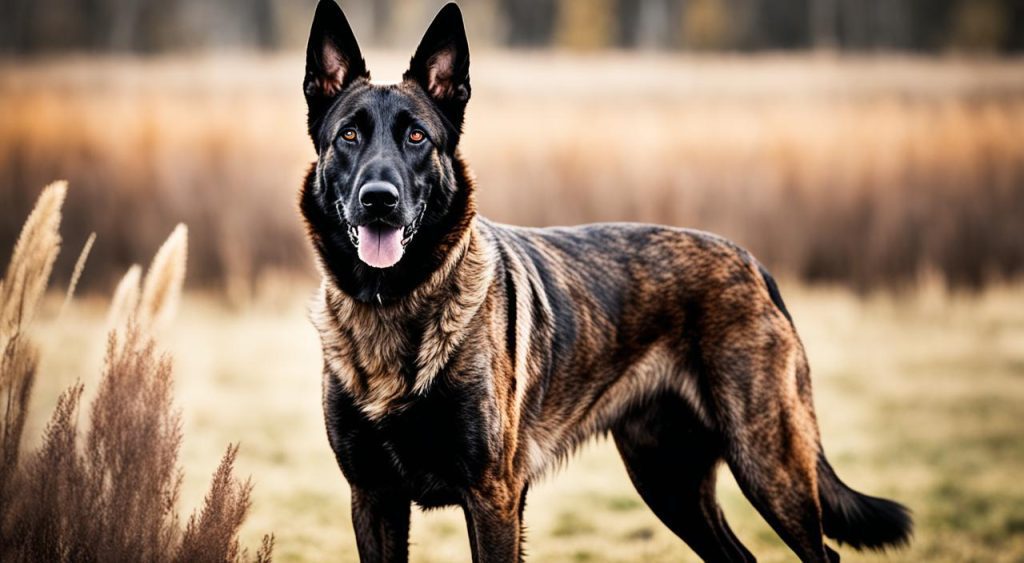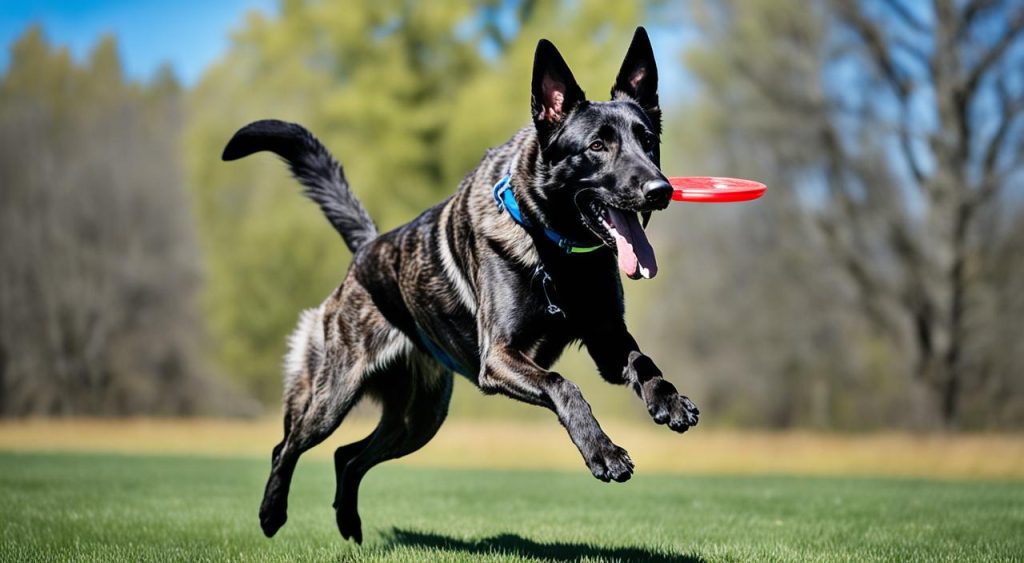The Dutch Shepherd is a loyal, smart, and versatile working dog with a long history. It dates back to the 18th century in rural Netherlands. Farmers and shepherds bred them to help with herding, guarding, and pulling carts.
They were essential because of their hard work and sharp mind. Now, they are in demand for search-and-rescue, police work, and other jobs. This is because they have great tracking skills and can be trained well.
Introduction to the Dutch Shepherd
The Dutch Shepherd, also known as the Hollandse Herder, comes from the Netherlands’ rural areas. Farmers and shepherds developed them in the early 1800s. They valued these dogs for their strength, smarts, and versatility in farm work.
Origin and History
These dogs trace back to the 1800s for herding, guarding, and farm tasks in the Netherlands. They were hard to tell apart from Belgian and German breeds. But, a breed standard in 1914 highlighted their unique brindle coat.
After World War II, the Dutch Shepherd breed was almost gone. But, it’s made a strong comeback. Now, these Dutch herder dogs are known for their skills and are in demand by services around the world.
Breed Characteristics
The Dutch Shepherd is a medium-sized breed. Males are 22.5 to 24.5 inches tall, and females are 21.5 to 23.5 inches. They weigh 45 to 75 pounds and live 11 to 14 years.
What makes the Dutch Shepherd stand out is its coat. It comes in short, long, and rough varieties. The brindle pattern, with silver and gold shades, gives them a unique look.
“The Dutch Shepherd is a breed that has truly stood the test of time, emerging from its humble farming roots to become a highly sought-after working dog in a variety of fields.”
The Physical Traits of Dutch Shepherds
Dutch Shepherds are a medium to large-sized breed. They are known for their athletic build and agility. They have a shoulder height of 21 to 24.5 inches and weigh between 42 to 70 pounds. This makes them well-suited for various activities.
Size and Weight
The dutch shepherd size and dutch shepherd weight vary by gender. Males are usually bigger than females. On average, males are taller, while females are lighter in weight.
Coat Colors and Patterns
The Dutch Shepherd has a dense, weather-resistant coat. It’s often short to medium in length and comes in a dutch shepherd brindle pattern. This pattern can be brownish, orange-brown, or yellow-brown. Other dutch shepherd coat colors include black, blue, and gray.
| Coat Type | Description |
|---|---|
| Short-hair | The most common coat type, with a dense, straight outer coat and a softer, downy undercoat. |
| Long-hair | A longer, slightly wavy outer coat with a softer undercoat. |
| Rough-hair | A wiry, harsh outer coat with a soft undercoat. |

“The Dutch Shepherd’s distinctive brindle coat pattern is a hallmark of the breed, setting them apart from other shepherd dogs.”
Dutch Shepherd Temperament and Personality
The Dutch Shepherd is known for its intelligence, loyalty, and high energy. These dogs were bred to be versatile and hardworking. They are very loyal and love their owners. Dutch Shepherds are affectionate, eager to please, and deeply devoted. They can be cautious around strangers and may bark to protect their family.
It’s important to socialize and train Dutch Shepherds early. This helps them become confident and well-adjusted. With the right training, they can do well in many homes, big or small. Their high loyalty and affection towards their owners make them great family pets. Their protective nature also adds security.
| Trait | Rating |
|---|---|
| Affection Level | High |
| Friendliness | High |
| Kid-Friendly | High |
| Pet-Friendly | High |
| Exercise Needs | High |
| Playfulness | Medium |
| Energy Level | High |
| Trainability | High |
| Intelligence | High |
| Tendency to Bark | Medium |
| Amount of Shedding | High |
Dutch Shepherds are very smart and love to learn. They do well in dog sports and activities. They need mental and physical challenges. Their versatility, combined with their loyal and affectionate nature, make them great companions for those who can give them the time and training they need.

“The Dutch Shepherd is a breed that embodies the perfect balance of intelligence, loyalty, and versatility. They are truly a remarkable working dog that can excel in a variety of roles, all while remaining a devoted and affectionate family companion.”
Training and Exercising Your Dutch Shepherd
Dutch Shepherds are smart and do well with positive training. They need consistent training from a young age. This helps them learn obedience and stops bad habits like too much barking or herding.
Mental Stimulation and Training
These dogs love to learn and enjoy challenges. Training them, agility courses, and dog sports are great. They also love puzzle toys and scent work, which keeps their minds sharp.
Exercise Requirements
Dutch Shepherds need lots of exercise every day. They should get 60-90 minutes of activity to be happy and healthy. Hiking, swimming, and fetch are perfect for them.
By giving your Dutch Shepherd enough exercise and training, you’ll get a loyal friend. These smart dogs need both physical and mental challenges. This helps them be the best part of your family.

| Training Tip | Exercise Recommendation |
|---|---|
| Use treats and praise to make training fun and rewarding. | Make sure they get 60-90 minutes of exercise daily. Include physical activities and mental challenges. |
| Add obedience, agility, and dog sports to their training. It’s good for their mind and strengthens your bond. | Give them a safe area to run and play. They’re energetic and have a strong herding instinct. |
| Be patient and use positive reinforcement when training. They’re sensitive to harsh corrections. | Keep them busy with interactive toys and puzzles when they’re not exercising. |
Dutch Shepherds as Working Dogs
The Dutch Shepherd is known for its high intelligence, sharp senses, and hard work. They are in high demand as working dogs. They work with police and the military for tasks like finding drugs or explosives, tracking, and protecting people. They also help in search-and-rescue missions, using their skills to find missing people.
Police and Military Work
Law enforcement and the military value Dutch Shepherds for their loyalty, ability to learn, and sharp instincts. They are trained for important jobs like finding drugs or bombs, chasing suspects, and protecting their handlers. Their agility, strength, and focus make them key in many security and combat roles.
Search and Rescue
Dutch Shepherds are great at tracking and working hard, making them perfect for search-and-rescue. They use their strong noses to follow faint scents and find missing people. They can work long hours in tough conditions, making sure no one is left behind.
Even though they’re not as common as some other breeds, Dutch Shepherds are highly valued for their skills and trainability. They play a crucial role in many important jobs, proving their worth in both civilian and military settings.
Grooming and Care for Dutch Shepherds
Looking after a Dutch Shepherd means you need to groom them regularly. Their thick, weather-proof coats need brushing every week. This helps control dutch shepherd shedding. When the seasons change, you might need to brush them more often.
When they get dirty or smell, it’s time for a bath. But remember, bathing too much can take away their coat’s natural oils.
It’s also important to trim their nails and clean their ears regularly. Dutch Shepherds don’t need professional grooming. But, owners should be ready to spend time on their coat and nail care. This keeps them healthy and comfy.
| Grooming Task | Frequency |
|---|---|
| Brushing | Weekly, with more frequent brushing during shedding seasons |
| Bathing | As needed when visibly dirty or smelly |
| Nail Trimming | Every 4-6 weeks |
| Ear Cleaning | Monthly or as needed |
By spending time on grooming, owners can keep their Dutch Shepherds healthy, comfy, and looking great.
“Proper grooming is essential for maintaining the health and appearance of a Dutch Shepherd. A little time and effort goes a long way in keeping these active, intelligent dogs looking and feeling their best.”
Health Concerns for the Dutch Shepherd
The Dutch Shepherd is usually a healthy breed, but they can face some genetic health issues. Owners should know about these issues to take care of their pets. Key health concerns include hip and elbow dysplasia, progressive retinal atrophy, gastric dilatation-volvulus (bloat), and degenerative myelopathy.
Hip and Elbow Dysplasia
Hip and elbow dysplasia are common in Dutch Shepherds. These conditions happen when the joints don’t form right, causing pain, swelling, and arthritis. Breeders check for these issues, and owners can reduce risks with proper diet, exercise, and vet care.
Other Potential Health Issues
Dutch Shepherds may also face genetic disorders like progressive retinal atrophy (PRA), which can cause blindness. They are also at risk for degenerative myelopathy, a spinal cord issue that can lead to mobility problems and paralysis. Owners should watch out for gastric dilatation-volvulus (bloat), a serious condition that needs quick vet care.
Being proactive about your Dutch Shepherd’s health is key to a long, happy life. This means getting pet insurance to cover unexpected medical costs.
Dutch Shepherd as a Family Companion
The Dutch Shepherd is a loving and eager-to-please breed, making them great dutch shepherd family dogs. They are smart, loyal, and love being part of active families. They enjoy going on outdoor adventures and trying out dog sports. With early socialization, they become gentle, fun, and okay with dutch shepherd children.
But, they have strong protective instincts. So, they need careful watching around little kids. Still, the dutch shepherd household can be a loving part of the right family. They need owners who can give them lots of dutch shepherd activity level and keep their minds busy.
Dutch Shepherds can change their energy to fit the situation, making them good for active families. They have a natural instinct to herd and guard. This makes them great companions, offering security and loyalty to their family.
FAQ
What is the origin and history of the Dutch Shepherd breed?
The Dutch Shepherd has a long history, starting in the 18th century in the Netherlands. Farmers and shepherds bred them for herding, guarding, and pulling carts. Their hard work and smarts made them key on farms.
What are the distinctive physical characteristics of the Dutch Shepherd?
Dutch Shepherds are medium to large dogs, standing 21-24.5 inches tall and weighing 42-70 pounds. They have a strong build and powerful legs for agility and endurance. Their coat is dense, short to medium, and often brindle, in shades of brown or yellow.
What is the temperament and personality of the Dutch Shepherd?
Dutch Shepherds are smart, loyal, and love to work. They bond well with their families and enjoy pleasing them. But, they can be wary of strangers and may bark to alert their owners.
What are the training and exercise requirements of the Dutch Shepherd?
Dutch Shepherds are smart and do well with positive training. They need consistent training from a young age to behave well. They also need lots of exercise to stay happy, enjoying activities like hiking and agility sports.
How are Dutch Shepherds utilized as working dogs?
Dutch Shepherds are great at police and military work because of their smarts and hard work. They’re used for detecting drugs, tracking, and protecting people. They’re also in search-and-rescue, using their tracking skills and endurance to find people.
What are the grooming and health considerations for Dutch Shepherds?
Dutch Shepherds need regular grooming to keep their coats in check. They’re generally healthy but can have health issues like hip and elbow dysplasia. Good breeders check for these problems, and owners can help with diet, exercise, and vet care.
How do Dutch Shepherds perform as family companions?
Dutch Shepherds make great family pets if you can give them enough exercise and mental challenges. They’re smart, loyal, and love to be active. With early socialization, they’re gentle and fun with kids.




